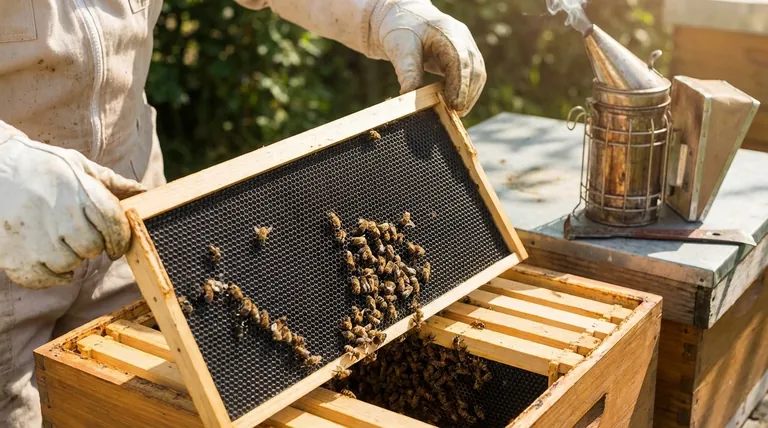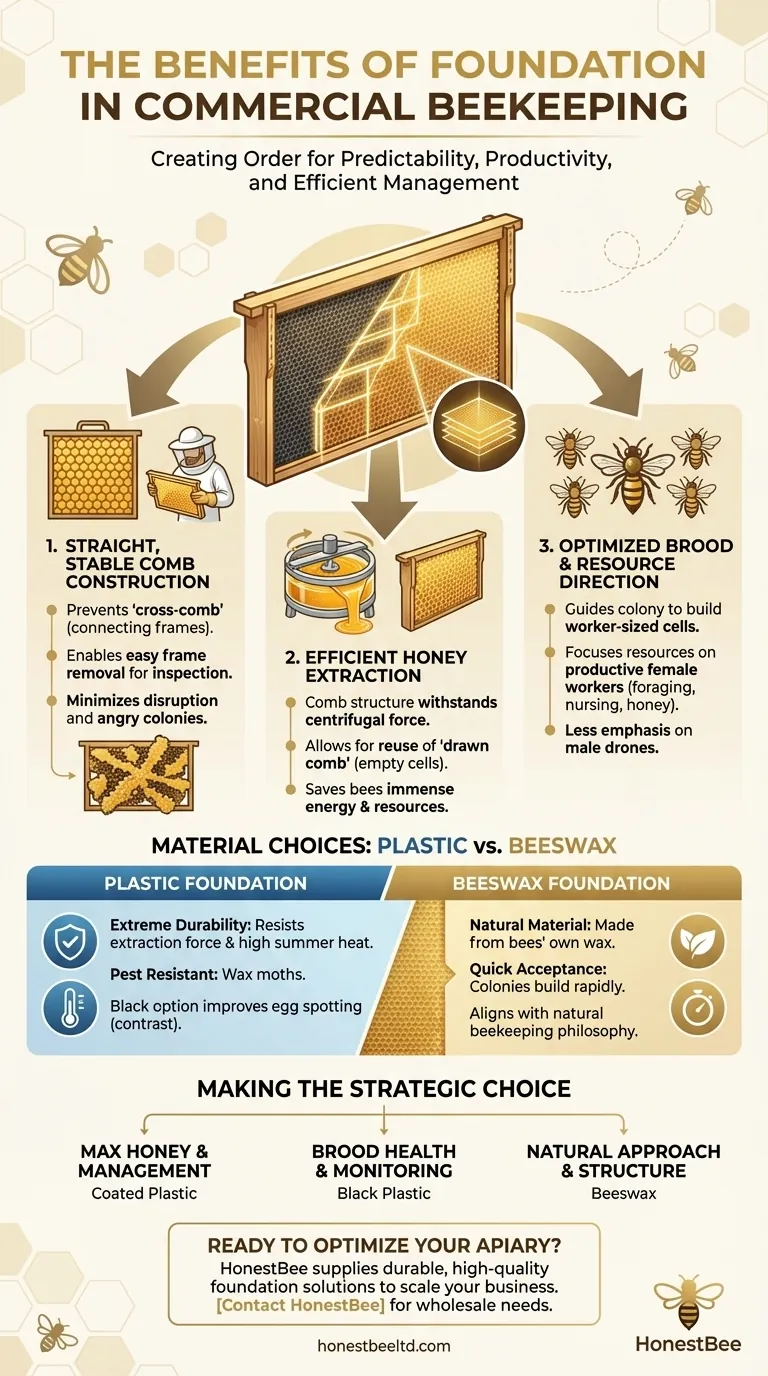In short, foundation is used in beekeeping to create order. It provides a structural template that guides bees to build straight, manageable combs, which dramatically simplifies hive inspections and makes honey extraction far more efficient. This control over the hive’s internal architecture is the primary reason it is a standard tool for most beekeepers.
The core decision is not whether to use foundation, but rather how much control you want over your hive. Foundation trades some of the bees' natural building instincts for significant gains in predictability, productivity, and ease of management for the beekeeper.

The Fundamental Purpose of Foundation
Foundation is a thin sheet of either plastic or beeswax, imprinted with a hexagonal cell pattern, that you place inside a hive frame. It acts as a blueprint for the bees.
Ensuring Straight, Stable Comb
Without guidance, bees will often build "cross comb"—comb that connects multiple frames together. This makes it nearly impossible to pull a single frame out for inspection without tearing the comb and angering the colony.
Foundation encourages bees to build straight within the confines of a single frame. This creates a well-organized hive where each frame can be removed, inspected, and replaced with minimal disruption.
Optimizing for Honey Extraction
Straight combs built on foundation are structurally sound. This strength is critical for modern honey harvesting, which uses a centrifuge (an extractor) to spin honey out of the cells.
A strong comb remains intact during this process, allowing you to return the empty "drawn comb" to the hive. This saves the bees an immense amount of energy and resources, as they don't have to rebuild the wax structure from scratch.
Directing Colony Resources
Foundation is typically printed with the cell size for worker bees. By providing this template, beekeepers encourage the colony to raise more female workers and fewer male drones.
Since workers are responsible for foraging, nursing, and honey production, this focus on worker brood can lead to a more productive and populous colony.
Comparing Materials: Plastic vs. Beeswax
The choice between plastic and beeswax foundation depends entirely on your goals, budget, and beekeeping philosophy.
The Case for Plastic Foundation
Plastic foundation is prized for its extreme durability and ease of use. It will not break during aggressive honey extraction or melt and collapse in high summer heat.
It is also resistant to pests like wax moths. Many beekeepers favor black plastic foundation in their brood boxes because the dark background makes it significantly easier to see tiny, newly-laid bee eggs.
The Case for Beeswax Foundation
Beeswax foundation is the more traditional choice. It is made from the bees' own natural material, and colonies typically accept it and begin building on it very quickly.
Many beekeepers prefer it because it aligns with a more natural beekeeping philosophy by avoiding the introduction of plastic into the hive environment. While more fragile than plastic, it is still far more durable than having no foundation at all.
Understanding the Trade-offs
Using foundation is a strategic decision, and it’s important to understand what you are giving up in exchange for the benefits.
The Cost of Control
The primary trade-off is sacrificing the bees' natural comb-building instincts for human-imposed order. In a completely natural state, bees would build comb of varying cell sizes to suit their immediate needs, including larger cells for drones. Foundation removes this choice.
Durability vs. Natural Appeal
While plastic is incredibly durable, it is a foreign material. Some colonies can be reluctant to build on it, and it often requires a coating of beeswax to encourage acceptance. Beeswax foundation is more naturally accepted but is more susceptible to damage from heat, pests, and rough handling.
The Ease of Egg Spotting
A key operational advantage of black plastic foundation is visibility. Spotting eggs is a critical skill for confirming your queen is healthy and laying. The contrast provided by black plastic makes this task much easier for new and experienced beekeepers alike.
Making the Right Choice for Your Goal
Your choice of foundation should directly support your beekeeping objectives.
- If your primary focus is maximum honey production and ease of management: Choose coated plastic foundation for its durability during extraction and resistance to high temperatures.
- If your primary focus is monitoring brood health and spotting eggs: Use black plastic foundation in your brood boxes to make inspections faster and more accurate.
- If your primary focus is a more natural approach while retaining hive structure: Beeswax foundation offers a good compromise, keeping the hive plastic-free while still guiding comb construction.
Ultimately, understanding foundation empowers you to manage your hives with intention and efficiency.
Summary Table:
| Benefit | Key Impact |
|---|---|
| Straight Comb Construction | Prevents cross-comb, enables easy frame inspection |
| Efficient Honey Extraction | Strong combs withstand centrifugal force in extractors |
| Optimized Brood Production | Guides bees to build worker cells for a more productive colony |
| Enhanced Hive Durability | Plastic foundation resists heat and pests; beeswax is naturally accepted |
Ready to optimize your apiary's productivity and efficiency?
As a commercial beekeeper or distributor, you understand that reliable, high-quality equipment is the foundation of a successful operation. HONESTBEE supplies the durable beekeeping supplies and equipment you need to scale your business.
Let us help you build stronger, more manageable hives. Contact HONESTBEE today to discuss your wholesale needs and discover how our foundation solutions can benefit your apiary.
Visual Guide

Related Products
- Food Grade Plastic bee Foundation for Bee Frames
- Beeswax Foundation Sheets Beehive Foundation for Wholesale
- Notebook Style Beeswax Foundation Mould Wax Foundation Mold
- Manual Beeswax Comb Foundation Machine Wax Foundation Mill Embossing Machine
- Professional Frame Preparation: The HONESTBEE Electric Wire Embedder
People Also Ask
- What is a plastic foundation sheet? A Durable, Reusable Hive Management Solution
- How to get bees to draw out plastic foundation? Boost Comb Building with Proven Tactics
- How to get bees to use plastic foundation? Master the Wax Coating and Resource Strategy
- What additional step can improve the performance of plastic foundation in the hive? Apply a Generous Coat of Beeswax
- Why is it beneficial to coat plastic foundation with beeswax? Boost Hive Acceptance & Comb Building



















